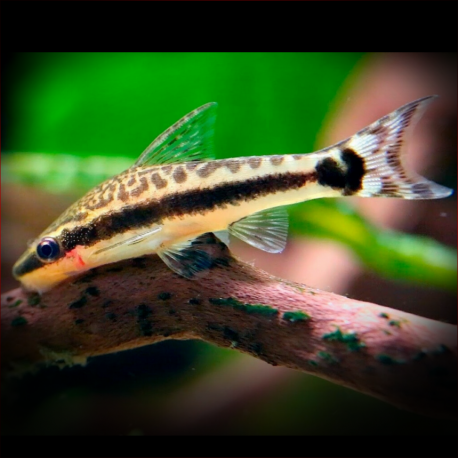More info
Datasheet
| Minimum Tank Size | 40 litres / 10.57 US gallons |
| Maximum Size | 3.5cm / 1.38inches |
| Temperature | 21°C / 69.80°F - 26°C / 78.80°F |
| Hardness | 1-12ºdH |
| pH | 5.5-7.5 |
General Description
The Otocinclus Macrospilus, belonging to the Loricariidae family under the Siluriformes classification order, is known for being a commonly kept and cherished species in the aquarium hobby. Typically reaching a maximum size of about 3.5cm, this fish is native to parts of the Upper Amazon in Peru, with additional recorded locations including the Nanay and Maranon basins in Colombia and the Napo basin in Ecuador. Its specific habitat consists of dense patches of marginal vegetation in streams, creeks, and rivers, as well as floating vegetation mats, providing a sanctuary alongside other fish species. The etymology of its genus name, Otocinclus, is traced back to Greek and Latin origins, referencing the fish's auditory organ's structure.
Aquarium Setup
For optimal care, it is recommended to maintain Otocinclus Macrospilus in a heavily planted tank with broad-leaved plants, driftwood branches, and potentially vertical rock surfaces. While the choice of substrate is not overly crucial due to the fish's behavior of staying away from the tank bottom, a sand substrate may be welcomed when the fish ventures downward to forage. Water conditions must be regulated within a pH range of 5.5-7.5, a temperature range of 21-26°C, and a water hardness of 1-12°dH.
Behaviour
The Otocinclus Macrospilus exhibits a very timid and retiring nature, making it susceptible to being outcompeted for food by more active tankmates. To thrive, it is recommended to house them with small, peaceful fish like characins, dwarf cichlids such as Apistogramma, and smaller Corydoras. Otocinclus Macrospilus tends to prefer the company of its own species, ideally forming a group of at least six individuals for a more harmonious environment.
Feeding and Diet
In their natural habitat, Otocinclus Macrospilus primarily feeds on algae and microorganisms. In captivity, their diet should predominantly consist of vegetable matter in fresh and dried forms, including zucchinis, cucumbers, blanched spinach, algae wafers, and spirulina tablets. While occasional live or frozen foods like bloodworms or daphnia are accepted, they should not be overfed, as the fish's protein requirements are minimal compared to their need for plant-based nutrition.
Reproduction & Dimorphism
Although successful breeding of Otocinclus Macrospilus has been documented, detailed information on the process is scarce. Similar to Corydoras species, spawning involves a 'T' position where the male clasps the female for egg and sperm deposition. The scattered eggs are commonly found among plants or tank glass. Factors triggering spawning include significant water changes with cooler water and the presence of another breeding species like Corydoras. Sexual dimorphism is most apparent when viewing the fish from above, with mature females exhibiting a broader body shape. The tiny fry necessitate ample access to algae and plant-based food sources for proper development.
Habitat and Distribution
Endemic to the Upper Amazon region in Peru and potentially extending to Colombia and Ecuador, the Otocinclus Macrospilus thrives in small to medium water bodies with an abundance of marginal vegetation for shelter and sustenance. Its presence in floating vegetation mats showcases its adaptability to various aquatic environments within its native range. The species' specific distribution originates from the Rio Morona in Peru, highlighting its concentration in the Amazon basin's diverse ecosystems.

